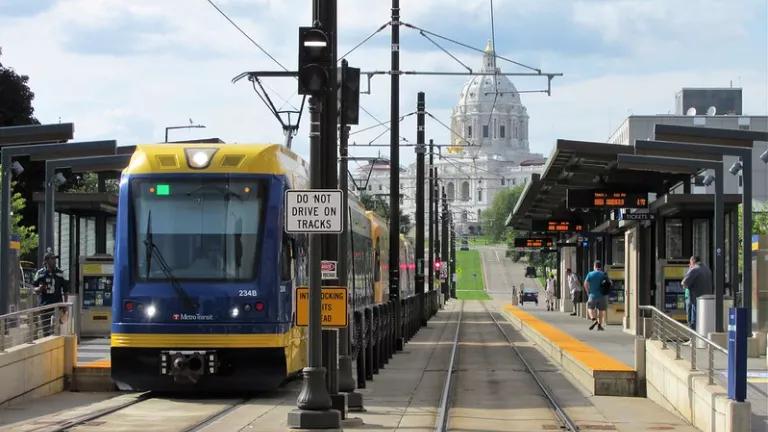Transportation Funding Gets a Potential Boost
A new bill from Congressman Hank Johnson could help secure desperately needed operations funding for transit agencies across the country.

A light rail train station in downtown St. Paul, Minnesota
Last week, Representative Hank Johnson (GA-04) reintroduced the Stronger Communities Through Better Transit Act, which aims to increase the amount of money available to transit agencies to provide reliable, safe, and accessible transit service for all. The bill authorizes $20 billion a year, across four years, for transit system operating budgets and has garnered support from a number of key transportation and climate advocates, including NRDC, the National Campaign for Transit Justice (NCTJ), and more than 60 congressional cosponsors.
Federal transportation funding has historically favored the maintenance and construction of highways, leaving very little money for public transit. About 80 percent of federal transportation funding is directed toward roads, while the remaining 20 percent goes to public transportation. By law, this money can only be used on capital expenses for buses, trains, ferries, and other modes of public transit.
In fact, a large proportion of federal funding prioritizes capital expenses and does little to support an increase in transit frequency or coverage. The bulk of funding for transit operations comes from state and local initiatives and fare revenues. And while many cities and states have identified policies (such as sales tax increases) to generate sustained operations-related funding for their transit systems, the fact remains that federal funds constitute just 7 percent of total transit operations funding, highlighting a real missed opportunity for the feds to play a role in fundamentally transforming public transit service and creating a transportation system that serves everyone.
The value of reliable transit service
At its most basic, public transit is the cleanest form of people movement. Compared to driving alone, public transit generates 45 percent fewer carbon dioxide emissions. But more important, it serves as a critical connector to goods and services, job centers, education, and other basic needs, and it can make or break the economic mobility of a given community. The lack of frequent and reliable public transit service across the country disproportionately impacts frontline and low-income communities, riders of color, and individuals with disabilities—populations that tend to rely on public transit as their primary mode of transportation. As an example, Black riders account for 24 percent of all transit riders, despite only being 12 percent of the total American population.
In conjunction with the release of the bill and Martin Luther King Jr. Day, NRDC and the NCTJ organized a briefing for congressional staffers to showcase the experience of frequent transit riders and to highlight the need for transit service expansion across the country. Attendees heard testimonials from nine different speakers, including Teaira Collins from Pittsburgh, Pennsylvania, who relies on public transit to not only get to work but to also get her youngest son to his frequent medical appointments. Collins expressed her frustration with the marked decline in bus service that she has seen in recent years, which has meant many missed appointments and major changes to her already busy schedule.
How would the Johnson bill address the gap in transit service?
As mentioned above, Representative Johnson’s bill would secure $20 billion in operating funding annually, distributed over a four-year period, by creating a new formula grant program called the High-Quality Transit Operating Support Program. The money from this grant must be used to make “substantial improvements to transit service” and can be spent on projects that will expand service frequency, hours, days, or areas, or to add new service. A small portion of this money can also be used on service planning and program evaluation. Lastly and importantly, most of the funding should be spent on projects in underserved communities, and grantees must report annually on key metrics, such as service frequency and access to jobs and services to measure success.
A recent analysis by the Union of Concerned Scientists and NCTJ looked at the state-by-state impact of an additional $20 billion in operations funding. Some states could see substantial funding increases; money that would go a long way to addressing existing service gaps. The new federal funding must also be matched by an equal amount of state or local funding, and grantees will have to show that state and local contributions aren't reduced due to the influx of federal funds. This will ensure that the federal funds make a real difference and don't displace existing funding sources.
The COVID-19 pandemic demonstrated the need for a robust transit system that connects people to essential services and helps defray transportation costs for the poorest households in the country. Long-term federal transportation funding must include money for operations in addition to capital projects to ensure that public transit is a clean, reliable, and safe mode of transportation for all.



